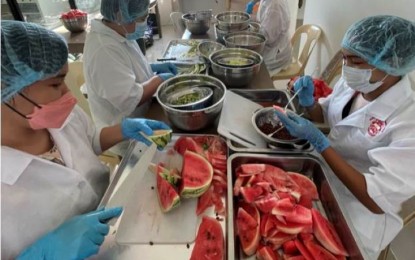
HEALTHY PRESERVATIVE. The University of Antique-Integrated Research Center (UA-IRC) processes watermelon into powder in this photo taken on Tuesday (Aug. 13, 2024). Danica Marie Aposaga, UA-IRC Product Standardization Officer, said in an interview Wednesday (Aug. 14) that they discovered that the watermelon waste made into Watermelon Powders (WamPow) is a healthy food preservative. (Photo courtesy of UA-IRC)
SAN JOSE DE BUENAVISTA, Antique – The University of Antique-Integrated Research Center (UA-IRC) discovered that the watermelon waste made into Watermelon Powders (WamPow) is a healthy food preservative.
UA-IRC Product Standardization Officer Danica Marie Aposaga said in an interview Wednesday that they discovered, based on their research, that using the watermelon peel and rind increases the nutrients or fiber in food, particularly on the pork longganisa or sweet sausage, in addition to having anti-cancer properties.
“We discovered that the waste of the watermelon could be used as a preservative and even additive on the pork longganisa,” she said.
She said that their team, composed of IRC director Jessebel Gadot and Centralized Analytical Testing Laboratory (CATL) Food and Microbiology Analyst Jemaica Labus, started in 2021 when she decided to come up with a study about the usage of watermelons that were left to rot in farms in Sibalom town.
“The watermelon waste as a food preservative is comparable with commercial preservatives. It extended the shelf life of the pork longganisa to 28 days,” she said.
She said they would like to conduct follow-up research to really determine the shelf-life of the longganisa because they believe it could extend even beyond 28 days.
She added they have partnered with the Sibalom Livestock and Poultry Raisers Association (SILPRA) to research the development of chicken and meat products.
SILPRA, which sells dressed chicken, plans to sell marinated chicken using the WamPow as a preservative.
The Pandan Multi-Purpose Cooperative also tied up with the center for use of the WamPow in its processed meat and baked products, like bread and pastries.
Meanwhile, Department of Science and Technology (DOST) Regional Director Rowen Gelonga said that the WamPow will be one of the innovations up for display during their 2024 Regional Science, Technology and Innovation Week (RSTW) hosted by the UA in Sibalom on Aug. 22-24.
“The WamPow is an innovation that is practical and has a potential in the market,” he said.
Gelonga also invited the stakeholders, particularly startup businesses, to take time for the RSTW to learn about the innovations in Antique and from the five other provinces in Western Visayas. (PNA)
